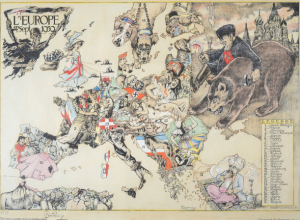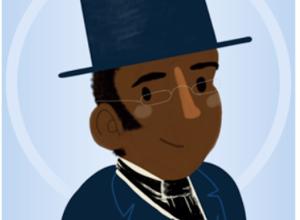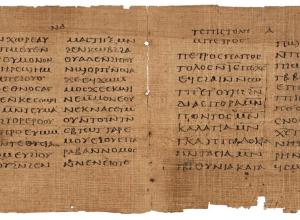War, Empire and Business: Jane Austen's Underexplored Life
 OXFORD—To mark 200 years since the death of Jane Austen, a major new exhibition at Oxford University’s Bodleian Libraries will challenge the current public perception of one of England’s greatest literary heroes.
OXFORD—To mark 200 years since the death of Jane Austen, a major new exhibition at Oxford University’s Bodleian Libraries will challenge the current public perception of one of England’s greatest literary heroes.
Which Jane Austen? presents Austen as an ambitious and risk-taking businesswoman and a wartime writer who was informed and inspired by the surprising international adventures of her family and relations. Through a spectacular selection of Austen materials displayed together for the first time, the Bodleian Libraries delve into the myriad influences on this great writer’s work.
Britain was at war with Revolutionary and Napoleonic France during most of Austen’s adult life and three of her brothers served in the military. This exhibition examines Austen as England’s novelist of the home front and war as the context for the quiet domestic lives of her characters. Novels like Pride and Prejudice, Mansfield Park and Persuasion are interpreted in the exhibition as wartime texts and set alongside other war writings including military treatises (of which Austen was an appreciative reader) and political cartoons.
The global journeys of Austen’s well-travelled family to India, Scandinavia, Africa, China, Canada and the West Indies provided her with a rich international outlook. Austen also read many books that dealt with the far corners of the British Empire. This exhibition illustrates the influence of these international links on Austen’s writing, through diaries, letters, naval logbooks and artefacts.
Also explored is Austen’s success as a professional writer. The exhibition charts her frequent visits to London to oversee the publication process of her books and to relish the cultural and commercial life of the capital. It traces in rich detail her relationship with John Murray II, the most glamorous publisher in London. Lord Byron and Walter Scott, the best-selling authors of the day, were on Murray’s list.
The Bodleian Libraries have extraordinarily rich Austen holdings and house one of the world’s three most significant collections of Austen materials. The exhibition will also feature items on loan from Oxford college collections, King’s College, Cambridge, Chawton House Library, Jane Austen’s House Museum, the British Library, the National Maritime Museum, Greenwich, and the John Murray Archive, National Library of Scotland.
Professor Kathryn Sutherland, curator of the exhibition and world-leading Austen expert at Oxford University, said: ‘Contrary to popular belief, Jane Austen was no retiring country mouse. And while it is assumed that, as an 18th century female, her context was local and her outlook parochial, Austen was always very much a writer of the world.
‘To mark the bicentenary of the death of one of our greatest literary heroes, this exhibition presents a 200-year journey ranging from Hampshire to the distant fringes of the British Empire, providing us with glimpses into the many lives of Jane Austen.’
Highlights of the exhibition will include:
- The Watsons, the earliest surviving manuscript of a novel by Jane Austen in process of development
- A copy of Volume the First, a collection of short stories, mini-plays, verses and moral fragments that Austen wrote between the ages of 12 and 18.
- Sanditon, the manuscript-novel left unfinished in the final months of her life, on loan from King’s College, Cambridge
- The logbook kept by Frank Austen as Post-Captain of HMS Canopus, open at his entry describing the Battle of Trafalgar and the death of Admiral Nelson
- A ticket of admission to the trial of Warren Hastings, impeached in 1787 on charges of corruption
- First-edition copies of Austen novels Pride and Prejudice, Mansfield Park and Persuasion open at passages relating to war
- Evidence of her professional dealings with her famous publisher, including a royalty cheque made out to ‘Miss Jane Austin’, which she counter-signed with the same spelling, showing how important her writing income was to her
- The household recipe book used in Chawton Cottage by the Austen women
- Austen’s writing desk and her hand-copied music books
- A wealth of family and professional letters that reveal Jane Austen in her own words
- A series of edited clips from the earliest to the most recent film and TV adaptations of the novels (presented in collaboration with the BBC)
A range of other national events will take place throughout 2017 to mark the 200th anniversary of the death of Jane Austen (18 July), including ‘The Mysterious Miss Austen’, an exhibition at the Discovery Centre, Winchester (13 May-24 July), and events at Jane Austen’s House Museum, Chawton, Hampshire.
Which Jane Austen?
The Weston Library, Bodleian Libraries, Oxford
23 June - 29 October 2017
Free admission, no booking required
Image: Front cover of the unique manuscript Volume the First, a collection of short stories, mini-plays, verses and moral fragments that Austen wrote between the ages of 12 and 18. In this volume, Austen transcribed some of her earliest fiction. She used a ready-made bound blank stationer’s notebook and, according to a final inscription, completed the transcription on 3 June 1793. Credit: Bodleian Libraries, University of Oxford















